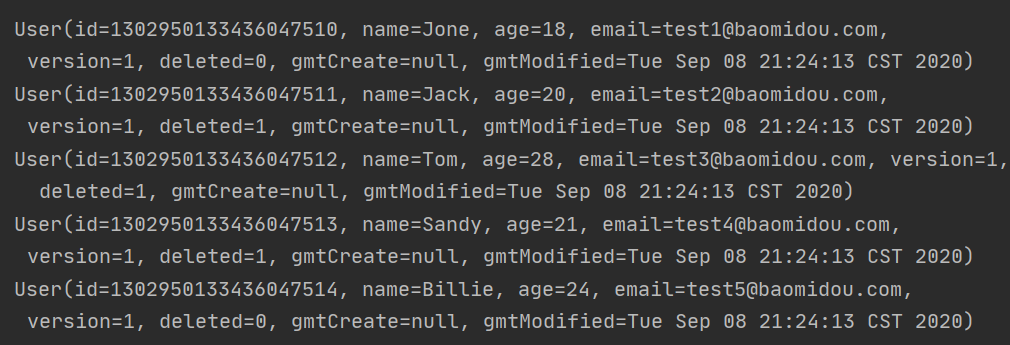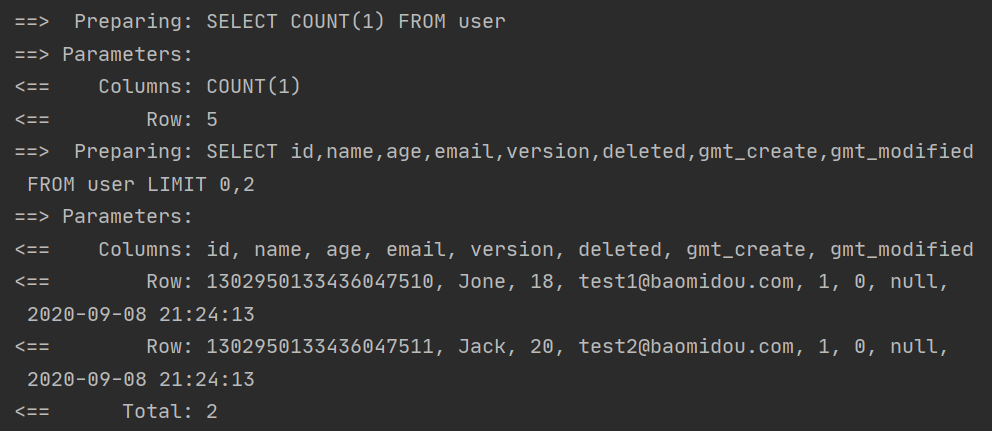1.简介
官网的地址: https://baomidou.com/

这些都是官网中写的 mybatis-plus 有哪些好处,下面通过官方文档进行学习:
2.快速入门
2.1 使用第三方组件 首先需要进行 导入依赖
<dependency>
<groupId>com.baomidou</groupId>
<artifactId>mybatis-plus-boot-starter</artifactId>
<version>3.2.0</version>
</dependency>
2.2 数据库中创建 表和插入数据 暂时都用官网中给的相应的数据
DROP TABLE IF EXISTS user; CREATE TABLE user ( id BIGINT(20) NOT NULL COMMENT '主键ID', name VARCHAR(30) NULL DEFAULT NULL COMMENT '姓名', age INT(11) NULL DEFAULT NULL COMMENT '年龄', email VARCHAR(50) NULL DEFAULT NULL COMMENT '邮箱', PRIMARY KEY (id) );

DELETE FROM user; INSERT INTO user (id, name, age, email) VALUES (1, 'Jone', 18, 'test1@baomidou.com'), (2, 'Jack', 20, 'test2@baomidou.com'), (3, 'Tom', 28, 'test3@baomidou.com'), (4, 'Sandy', 21, 'test4@baomidou.com'), (5, 'Billie', 24, 'test5@baomidou.com');
其中 后边需要用到 逻辑删除 插入时间 ,更新时间和乐观锁 在数据库中添加相应得字段
2.2.1 在application.properties 文件中填写 链接数据得代码

#链接数据库 spring.datasource.driver-class-name=com.mysql.cj.jdbc.Driver spring.datasource.username=root spring.datasource.password=8020 spring.datasource.url=jdbc:mysql://localhost:8020/mybatis?useSSL=false&useUnicode=true&characterEncoding=utf-8&serverTimezone=GMT%2B8
2.3 创建 springboot 项目 导入下面得依赖

<dependency>
<groupId>org.springframework.boot</groupId>
<artifactId>spring-boot-starter</artifactId>
</dependency>
<!--数据库驱动-->
<dependency>
<groupId>mysql</groupId>
<artifactId>mysql-connector-java</artifactId>
</dependency>
<dependency>
<groupId>org.projectlombok</groupId>
<artifactId>lombok</artifactId>
<optional>true</optional>
</dependency>
<dependency>
<groupId>com.baomidou</groupId>
<artifactId>mybatis-plus-boot-starter</artifactId>
<version>3.4.0</version>
</dependency>
引入mybatis-plus包就不用再mybatis 和mybatis-spring 的包 ,官网也明确的表明了

2.4 创建实体类

@Data @AllArgsConstructor @NoArgsConstructor public class User { private Integer id; private String name; private Integer age; private String email; private Integer version; private Integer deleted; private Date gmtCreate; private Date gmtModified; }
2.5 写一个mapper 接口继承BaseMapper
2.6 在主程序入口 填写 注解 @MapperScan("com.qlx.mapper")
2.7 编写测试类

@Test void contextLoads() { List<User> userList = userMapper.selectList(null); userList.forEach(System.out::println); }
结果为:

3.配置日志
#配置日志 在控制台输入即可 配置好之后再执行 会再控制台输入我们想要的sql 语句 到底是咋样的 mybatis-plus.configuration.log-impl=org.apache.ibatis.logging.stdout.StdOutImpl
4.CRUD
4.1插入操作

@Test public void testInsertUser(){ User user = new User(); user.setName("哈哈"); user.setEmail("哈哈@哈哈.com"); int count = userMapper.insert(user); System.out.println(count); }
执行的结果 查看日志:

我们在测试的时候只插入了 name和email id却为我们自动生成了 (这里使用了 雪花算法),,我们可以通过在属性值上面添加注解 @TableId(type = IdType.ID_WORKER)

/** * 数据库ID自增 */ AUTO(0), /** * 该类型为未设置主键类型 */ NONE(1), /** * 用户输入ID * 该类型可以通过自己注册自动填充插件进行填充 */ INPUT(2), /* 以下3种类型、只有当插入对象ID 为空,才自动填充。 */ /** * 全局唯一ID (idWorker) */ ID_WORKER(3), /** * 全局唯一ID (UUID) */ UUID(4), /** * 字符串全局唯一ID (idWorker 的字符串表示) */ ID_WORKER_STR(5);
4.2 更新操作

@Test void testUpdateUser(){ User user = new User(); user.setId(1303515878754709505L); user.setName("呵呵"); userMapper.updateById(user); }
控制台输入的sql日志:

4.3查询操作
List<User> userList = userMapper.selectList(null); userList.forEach(System.out::println);

4.4 删除操作
userMapper.deleteById(1303515878754709505L); //就可以删除成功
5.自动更新
在系统中,创建用户和更新用户信息 都是需要系统自动的 保存时间 这里有两种办法
第一种: 在数据库中 相应的字段中添加默认值 currenttimestamp
第二种就是使用 在属性值上添加注解:
@TableField(fill = FieldFill.INSERT) private Date gmtCreate; @TableField(fill = FieldFill.INSERT_UPDATE) private Date gmtModified;
6.乐观锁
乐观锁实现方式:
①取出记录时,获取当前 version
②更新时,带上这个version
③执行更新时, set version = newVersion where version = oldVersion
④如果version不对,就更新失败
在相应的字段上添加 注解@Version
执行 更新操作
@Test public void testOptimisticLocker(){ // 1、查询用户信息 User user = userMapper.selectById(1302950133436047514L); // 2、修改用户信息 user.setName("呵呵"); user.setEmail("呵呵@呵呵.com"); // 3、执行更新操作 userMapper.updateById(user); }
7.分页查询
注册组件
// 分页插件 @Bean public PaginationInterceptor paginationInterceptor() { return new PaginationInterceptor(); }
测试代码:
// 测试分页查询 @Test public void testPage(){ // 参数一:当前页 // 参数二:页面大小 // 使用了分页插件之后,所有的分页操作也变得简单的! Page<User> page = new Page<>(1,2); userMapper.selectPage(page,null); page.getRecords().forEach(System.out::println); }

8.逻辑删除
8.1 区别
物理删除 :从数据库中直接移除
逻辑删除 :再数据库中没有被移除,而是通过一个变量来让他失效! deleted = 0 => deleted = 1
8.2 导入组建
// 逻辑删除组件! @Bean public ISqlInjector sqlInjector() { return new LogicSqlInjector(); }
8.3 配置逻辑删除
# 配置逻辑删除 mybatis-plus.global-config.db-config.logic-delete-value=1 mybatis-plus.global-config.db-config.logic-not-delete-value=0

